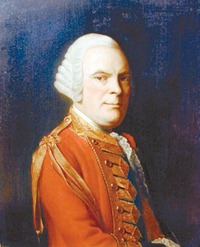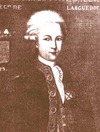
Source: Courtesy of Wikimedia Commons
ABERCROMBY, JAMES, army officer; b. 1706 in Banffshire (now part of Grampian), Scotland, son of Alexander Abercromby and Helen Meldrum; m. Mary Duff, and they had one daughter; d. 23 April 1781 at Glassaugh, Banffshire.
James Abercromby started his military career at the age of 11 by entering the 25th Foot as an ensign. Promotion during the peaceful Walpole era was not promising, and by 1736 he was only a captain, albeit in the 1st Foot. Like many officers, Abercromby entered politics to seek advancement, and in 1734 he was elected member of parliament for Banffshire on the interest of his brother-in-law William Duff, later Lord Braco. The government partially rewarded Abercromby for his support by appointing him lieutenant governor of Stirling Castle in 1739. The outbreak of war with Spain and later France brought better times for the military profession, and Abercromby was promoted rapidly, becoming colonel in 1746. That year he served as quartermaster general in the unsuccessful expedition against Lorient, France. He continued on active service until wounded at Hulst (Netherlands) the following year.
After the treaty of Aix-la-Chapelle in 1748 Abercromby retired, and he remained in comparative obscurity until the outbreak of the Seven Years’ War. Sent to North America early in 1756 as deputy to the Earl of Loudoun, the British commander-in-chief, he was promoted major-general and made colonel of the 44th Foot. Under Loudoun Abercromby showed himself a loyal, tireless, and entirely uninspired subordinate, commanding a brigade in the force that Loudoun assembled at Halifax, Nova Scotia, in 1757 for an expedition against Louisbourg, Île Royale (Cape Breton Island). Following Loudoun’s recall to England later that year, Abercromby was promoted commander-in-chief in North America. For the 1758 campaign, the British army was divided into three corps: one under Jeffery Amherst to renew the assault on Louisbourg, a second under John Forbes* to take the strategic post of Fort Duquesne (Pittsburgh, Pa), and the third under Abercromby to invade Canada by way of Lake George (Lac Saint-Sacrement) and Fort Carillon (Ticonderoga, N.Y.).
This operation gave Abercromby an opportunity to distinguish himself, but he was unhappy with his command. Amherst had been allocated the cream of the army and most of the supplies, leaving Abercromby with a large number of ill-disciplined provincial troops and insufficient artillery. But, aided by his energetic quartermaster general, John Bradstreet, and his charismatic second in command, Viscount Howe (George Augustus Howe), Abercromby opened the campaign early in July 1758 with an army of 6,000 regulars and 9,000 provincials. Crossing Lake George he landed with his army three miles south of Carillon on 6 July. The army’s initial advance ended in confusion as the troops lost their way in the dense forest. Lord Howe, the moving spirit of the expedition, was killed during a brief skirmish. Despite this setback, Abercromby regrouped his army. Early on the morning of the 8th he discovered that the French commander, Montcalm*, was hastily entrenching his force of some 3,500 men behind a rough breastwork of fallen trees. Led to believe that the French expected substantial reinforcement shortly, and advised by his engineers that the French works were as yet not formidable, Abercromby ordered an immediate assault without waiting for his artillery or attempting a formal siege. The attack was a disaster, for despite the heroic endeavours of the troops the enemy defences could not be breached. After four hours it was abandoned, leaving 1,944 British casualties.
His army shattered, Abercromby retreated up Lake George and waited for reinforcements. The retreat was his second serious error, for his forces were still superior to Montcalm’s and by bringing up his artillery he might yet have compelled the French to retire. But disheartened by his heavy losses, especially in officers, and lacking confidence in his provincial troops, he decided to do nothing further until he heard from Amherst. Abercromby’s responsibility for this disappointing end and his general incompetence for high command were now fully recognized by the government, and he was recalled in September.
Abercromby did not see active service again, though by the normal process of seniority he had risen to the rank of full general by 1772. He died at Glassaugh in 1781, having spent the last 20 years of his life there in retirement.
BL, Add. mss 32884. Huntington Library, Abercromby papers, AB 216. PRO, PRO 30/8/98. Correspondence of William Pitt (Kimball). [John Forbes], Writings of General John Forbes, ed. A. P. James (Menasha Wis., 1938). Gentleman’s Magazine, 1781, 242. DAB. Joseph Foster, Members of parliament, Scotland . . . (2nd ed., London and Aylesbury, Eng., 1882), 3. Sedgwick, House of Commons, I, 406. Pargellis, Lord Loudoun, 74.
© 1979–2024 University of Toronto/Université Laval
Image Gallery

Cite This Article
Richard Middleton, “ABERCROMBY, JAMES,” in Dictionary of Canadian Biography, vol. 4, University of Toronto/Université Laval, 2003–, accessed April 26, 2024, http://www.biographi.ca/en/bio/abercromby_james_4E.html.
The citation above shows the format for footnotes and endnotes according to the Chicago manual of style (16th edition). Information to be used in other citation formats:
| Permalink: | http://www.biographi.ca/en/bio/abercromby_james_4E.html |
| Author of Article: | Richard Middleton |
| Title of Article: | ABERCROMBY, JAMES |
| Publication Name: | Dictionary of Canadian Biography, vol. 4 |
| Publisher: | University of Toronto/Université Laval |
| Year of publication: | 1979 |
| Year of revision: | 1979 |
| Access Date: | April 26, 2024 |





















